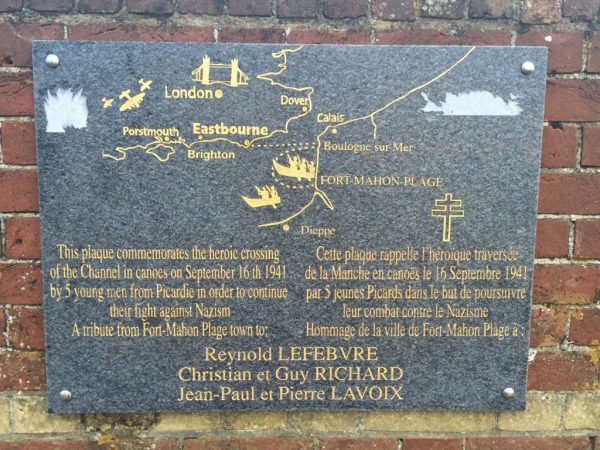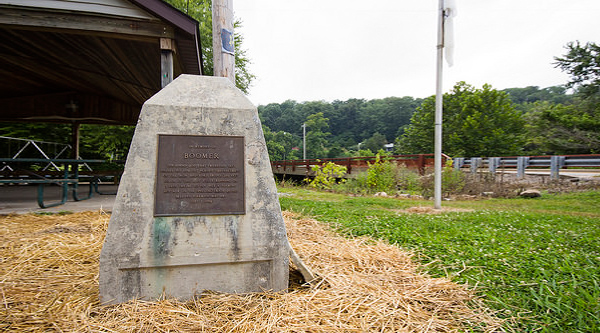Here at 99% Invisible, the phrase “always read the plaque” has become a mantra with a deeper meaning: it is not just about reading actual plaques, but also a broader call to look more closely for stories embedded in everyday built environments.
This plaque-reading dictum also retains a literal dimension, embodied in a website that grew out of an interview with John Marr (of Murder Can Be Fun) and subsequent conversation between Roman Mars and Alexis Madrigal (of Fusion), who launched the site.

Over the years, Kester Allen has continued to maintain, improve and further develop Read The Plaque, importing thousands of plaques from other websites around the world in the process. Thanks to these and other contributions, the site’s collection recently surpassed 10,000 plaques.
Each plaque page features locations, descriptions and pictures. Plaques are sorted by place and accompanied by descriptive text and topical tags. You can browse through them on a large map, find nearby plaques thanks to a custom geo-location feature or surf them at random. And, of course, if you find a plaque in your travels, you can (and should!) submit it to the site.
Below are just a few choice examples to pique your interest in plaques, commemorating everything from fire hydrants and loyal hounds to resistance fighters and space explorers:

In the wake of the 1906 San Francisco earthquake, a great fire swept the city. Many of the water mains failed and lines ran dry, but one hydrant continued to function and is credited with helping save the Mission District from total destruction. Today, the hydrant has been painted gold and has its own plaque. Click here to see it up close.

As the Lewis & Clark expedition team made their away across the Northwestern United States and back again, it was vital for them to salt and preserve meat. This Salt Cairn plaque near Fort Clatsop, Oregon, marks where three men built a camp and set up five boiling kettles to produce salt from the sea. Nearly two months later, they left to head back east with 28 gallons of “excellent, fine, strong and white salt.” The site was memorialized in part thanks to the memory woman who recalled this the spot where she (as a young girl) had seen men sitting around their fires. Click here to see more Lewis & Clark plaques.

Readers can thank actor and comedian Eddie Izzard for spotting this memorial to the French Five, a handful of young men who fled occupied France in World War II to continue fighting alongside the British. Not only did these brave souls escape from behind Nazi lines, but they did so by canoeing across 60 miles of open sea.

Of course, not all plaques document something of international (or even national) importance. The local legend of Boomer the hound dog is recorded in a strange inscription on this monument in Illinois: “Tradition says he dashed his life out against the iron abutment of the railroad bridge 300 feet south of this point on September 2, 1859, while running along on three legs trying to put out the flame in a hotbox on the speeding train of his beloved fireman-master.”

99pi’s own Kurt Kohlstedt discovered this mysterious Wild Oats Underdone Asparagas Boil plaque on a house near where he was living in West Oakland. It is tucked behind a fence and hard to photograph, but reads: “On or near this site in June 1968 more or less was staged the first WILD OATS UNDERDONE ASPARAGAS BOIL where strong kidneys gave way to strong appetites and stronger streams. Perpetrated by MARK KELLEY, Boiler, and HARRY ANTHONY, Streamer.” If you know anything about this plaque, please add a comment below!

In a few cases, you might find a plaque that cannot even fit on the RTP global map. This Fallen Astronaut sculpture and plaque were left on the moon by the crew of Apollo 15 in 1971. The statue and marker are dedicated to those who perished in the advancement of space travel. Another fascinating plaque was assembled in space by astronauts and cosmonauts a few years later as a symbol of international partnership.

Looking for more? Other plaques of potential interest on the RTP website include: Machiavelli’s Tomb, JB-2 Loon Missile, Site of Pump House, Site of Smaller Fort, The ACM Cat, The Ropely Racing Stones, Laura’s Dugout Home and especially: Near Here. You can also check out the map and zoom in to find further fascinating plaques near you.

Whatever you do, just remember: always read the plaque.



Comments (7)
Share
Re: The golden hydrant.
The USE of font size on the plaque somewhat AMAZES me.
I certainly value more when wit emphasizes words rather than width.
org — This website shares code and protocol for adding tags
to your web pages to create rich snippets, which are better looking search results that your audience is more likely to click
on when searching for what you have. Yes, the kind where you have to step
outside your comfort zone and actually write something meaningful.
With SHIPTRONITE you can now get what you want from the merchant
you want to get it from.
Hakim Bey purposes in TAZ (Temporary Autonomous Zone) that regular folks put up plaques commemorating events of importance in our own lives. Like: first place I ever had sex in a public place,or where I met the love of my life, for examples.
proposes
I love 99PI. I discovered your podcast after seeing Flag TEDTalk.
Anyway, I knew there was something I loved about you.
I’m still going through all your episodes when I came across this one-Always read the Plaques-
A few months ago I wrote this-
https://thisisloit.wordpress.com/2017/08/08/for-eric-c-wurman-life-after-death-ii/
It’s a short post on my blog about how my imagination was captured on one of those dedication plaques on the benches at Central Park.
I already was a plaque-reader and I’m glad that there is a wonderful podcast for people like me and others.
Hatzlacha Rabbah-I wish you much success.
Know who else has mapped out thousands of monuments and plaques? Pokemon Go. Most of their interaction points are at monuments and plaques.
When I was growing up near Schenectady, NY in the 1960s, a plaque on a metal stake appeared, on the side of Freeman’s Bridge Rd., near the eponymous bridge over the Mohawk river. The blue plaque withe raised, yellow lettering looked exactly like the standard NY State historical markers (aka plaques) which we saw marking colonial settlements, battle sites, etc. This one said: “Former site of Randall Lake. Still no fishing.” It disappeared a while later, with no more fanfare than when it showed up. It was fondly remembered by my family; I have wondered what interesting person created and installed it…I wish I had a picture to submit!